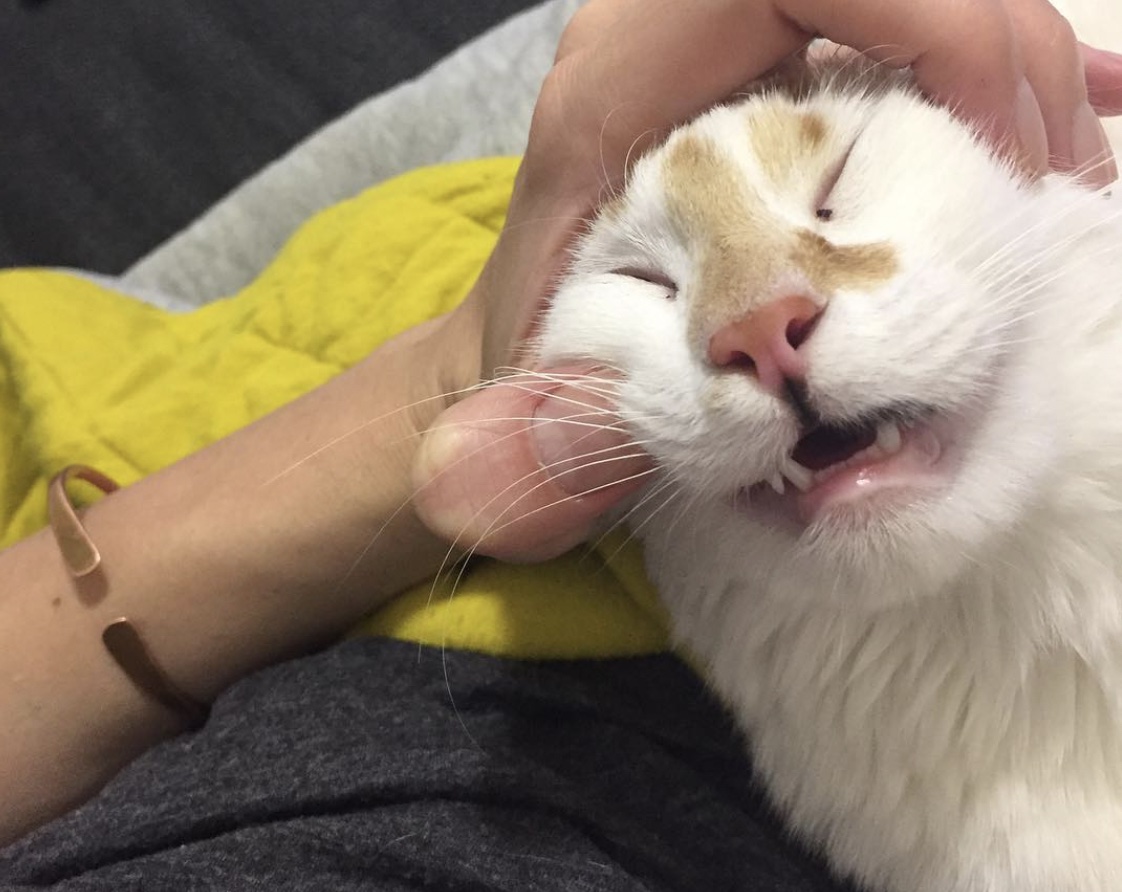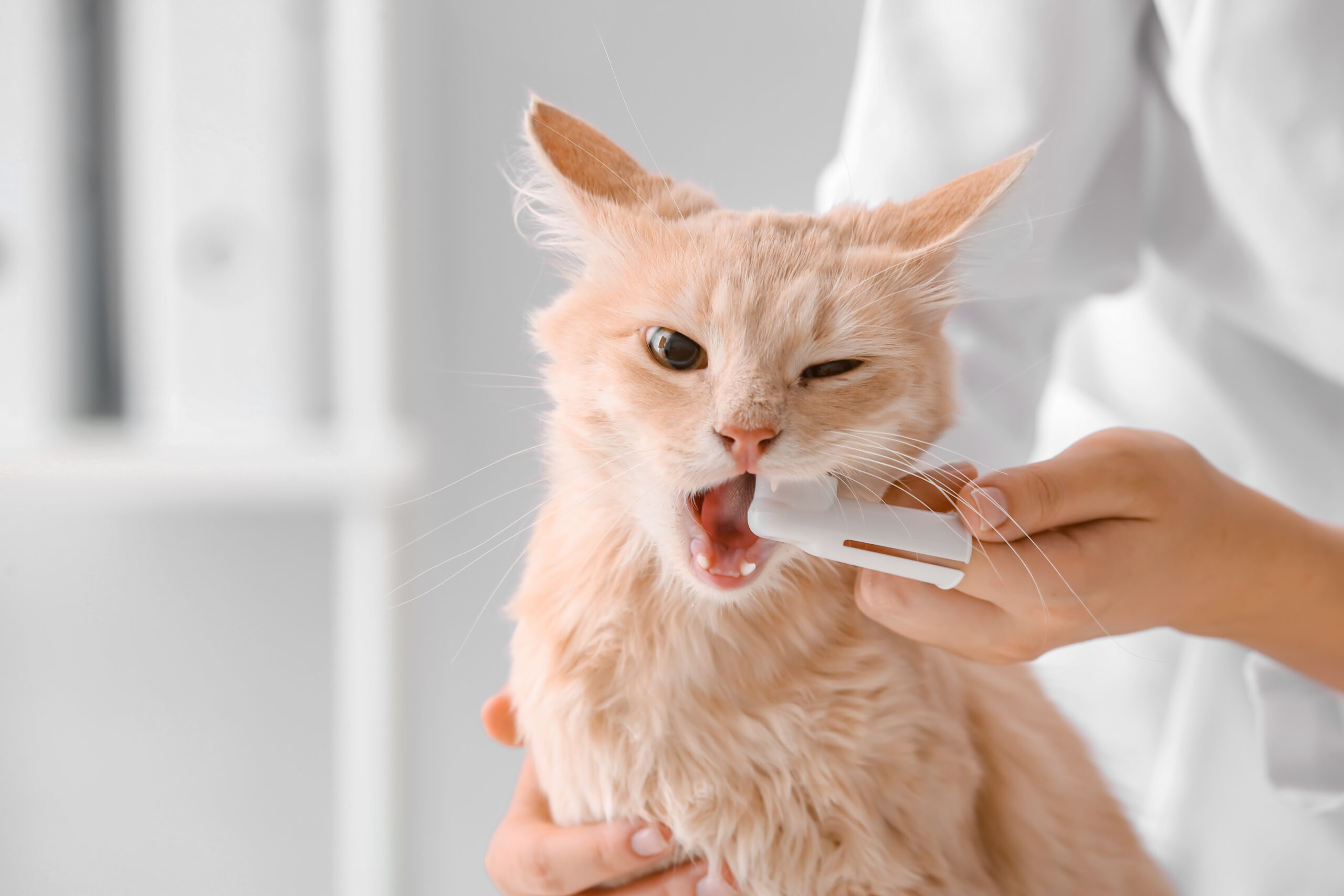What To Know About Cleaning Your Cat’s Teeth
Grab that ball of yarn, and start flossing!

Grab that ball of yarn, and start flossing!

Cats are great at a lot of things: napping, self-grooming, prowling around your apartment with maximum swagger. One thing they’re not so great at? Brushing their teeth.
It’s no surprise that your kitty could use a hand keeping their sharp, pearly white clean and healthy. If you neglect this part of their care, chances are your cat will need to go to the vet for the occasional deep cleaning and dental care—and that can get pricey.
The good news is that by staying on top of your cat’s dental hygiene, you can prevent all sorts of potential health issues and minimize the need for professional cleanings.
Feline oral hygiene is about a lot more than having a winning smile. Cleaning your cat’s teeth today can help to prevent a whole host of health issues tomorrow.
If cats don’t receive cleanings, plaque can build up on their chompers. If that plaque isn’t removed, it can harden into tartar. Tartar can contribute to serious oral problems like gum disease, also called gingivitis.
Caring for your cat’s teeth can also help to prevent tooth decay, tooth abscesses, tooth loss, mouth infections, and other unpleasantness (not to mention plain old bad breath). It can also lessen the risk of serious health issues, from periodontal disease to oral cancer to heart disease.

Any brushing that you can do at home is good for your cat, but getting into a daily brushing routine is the best way to keep your cat’s teeth healthy and shining.
The brushing frequency you can manage will depend on what your cat tolerates, but many cats can learn to cooperate with having their teeth brushed… especially if there’s a treat waiting for them afterwards.
To increase the chances of a successful brushing regiment, it’s best to introduce the routine when your cat is a kitten, if possible. Be patient. Brushing your cat’s teeth might seem crazy or indulgent at first, but it’s a necessary part of being a great pet parent, and your cat will become more cooperative over time.
When brushing your cat’s teeth, it’s important to use the right tools.
You can use a small toothbrush designed for cats, but a toothbrush designed for a human baby can also work. (Adorbs.)
Some cat owners find that using finger toothbrushes, which fit over the finger, gives them more control, while others prefer to simply wrap a piece of gauze around their finger and brush with that.
It’s also important to choose a toothpaste that’s designed specifically for cats. Cat toothpastes are available in flavors that your kitty will find tasty, including options like chicken and tuna. Never use human toothpaste on your cat, since it can make your cat very sick as it contains xylitol—a sugar-free sweetener that is harmless to humans but very dangerous to dogs and cats.
To start introducing the idea of brushing your cat’s teeth, put just a little toothpaste on your finger and wipe it over your cat’s gum line. Gradually increase the amount of time that you spend touching your cat’s gums, and focus on the exterior of your cat’s teeth, too.
Once your cat starts to relax and get used to having you touch their gums, you can transition to using a toothbrush. Gradually increase your brushing times. Start moving in small, circular motions and focus on the base of the teeth, where they meet the gums, since this is where plaque and tartar build up.
Ultimately, aim to brush your cat’s teeth for two to three minutes a day. Make sure that you’re gentle and patient with your cat, and try to time the brushings for periods in the day when your cat is already relaxed, like after a meal.

In addition to brushing your cat’s teeth at home, it’s also important for your cat to go to the vet for periodic professional dental cleanings.
During these cleanings, your cat will be put under general anesthesia, allowing your vet to do a thorough cleaning to remove any tartar that you haven’t been able to reach yourself. Your vet will also take any x-rays needed to evaluate your cat’s oral health, and may also perform tooth extractions if necessary.
The recommended frequency for these cleanings depends on your cat’s age, oral health, and how well you’re able to brush your cat’s teeth at home. Your vet can provide you with a recommendation based on your cat’s specific health and situation.
The American Veterinary Dental College recommends that cats get annual teeth cleanings, as 87% of cats over the age of the 3 have periodontal disease.
Cleaning could run from $500 up to $1,000, and more if you need oral radiographs. Going to a veterinary dental specialist for cleaning and tooth extractions could come to $2,000–$3,000.
Luckily, Lemonade offers a Preventative+ package will help pay for your cat’s routine dental cleaning (in addition to other services and necessaries, like wellness exams and vaccines).
Want to really be a master of feline oral hygiene? Lemonade has a dental illness add-on, which can help cover the cost of treatments, procedures, diagnostics, and medications related to dental illness. This includes crowns, extractions, root canals, dental surgeries, and treatments for gum disease like gingivitis and periodontal disease.
In addition to brushing your cat’s teeth, you can use many other products to support your cat’s dental health.
Dental treats and prescription diets feature textures designed to help scrape plaque from cats’ teeth as they chew. You can also find dental cat toys with rougher textures that scrape against your cat’s teeth and gums, helping to scrub away plaque.
You might also consider using one of the available water additives to help protect your cat’s teeth. Dental sprays and dental gels are also an option, and you can apply these products right at home.
The Veterinary Oral Health Council maintains a list of accepted products for cats. This list is a great place to start if you’re looking for additional ways to keep your cat’s teeth healthy. Your vet can also recommend options that are right for your cat.
Cat teeth cleaning can help to prevent serious, expensive dental issues like dental disease and tooth abscesses. By brushing your cat’s teeth and keeping up with regular veterinary checkups, not only will you be protecting your kitty’s pearly whites, but you’ll also be protecting your cat’s overall health.
Brushing your cat’s teeth each day will become a natural part of your routine, and is one part of giving your pet the healthiest, happiest life possible. That’s something to smile about.
A few quick words, because we <3 our lawyers: This post is general in nature, and any statement in it doesn’t alter the terms, conditions, exclusions, or limitations of policies issued by Lemonade, which differ according to your state of residence. You’re encouraged to discuss your specific circumstances with your own professional advisors. The purpose of this post is merely to provide you with info and insights you can use to make such discussions more productive! Naturally, all comments by, or references to, third parties represent their own views, and Lemonade assumes no responsibility for them. Coverage and discounts may not be available in all states.
Please note: Lemonade articles and other editorial content are meant for educational purposes only, and should not be relied upon instead of professional legal, insurance or financial advice. The content of these educational articles does not alter the terms, conditions, exclusions, or limitations of policies issued by Lemonade, which differ according to your state of residence. While we regularly review previously published content to ensure it is accurate and up-to-date, there may be instances in which legal conditions or policy details have changed since publication. Any hypothetical examples used in Lemonade editorial content are purely expositional. Hypothetical examples do not alter or bind Lemonade to any application of your insurance policy to the particular facts and circumstances of any actual claim.